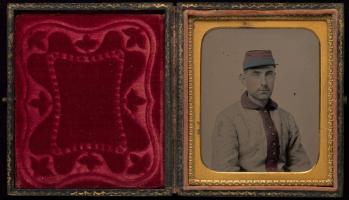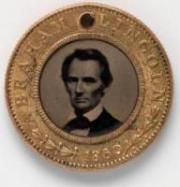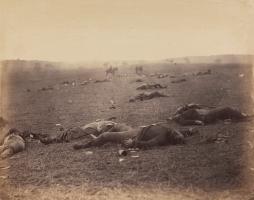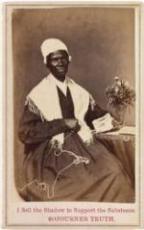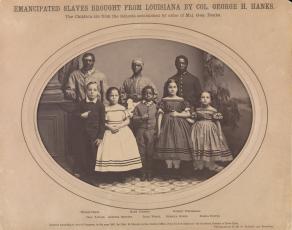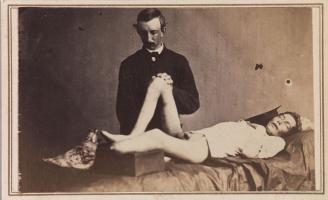CURATOR'S CHOICE SM
Exhibition Reviews
| Home | | Museum
Guide | | International |
| Theater |
History Through Photography
By Adèle Bossard
Next July will
mark the sesquicentennial (150th anniversary) of the Battle of Gettysburg
and it is soon after the hit of Steven Spielberg's last movie “Lincoln.”
Now the Met Museum offers, in its turn, to explore the Civil War, this
time through the lens of a camera.
With “Photography
and the American Civil War,” on view through September 2, 2013,
the Metropolitan Museum of Art explores the bloodiest war of American
history through the lens of a newborn medium, since the first photograph
of history was taken less than 50 years before the Civil War began.
The museum has
compiled more than 200 poignant photographs that capture the four-year
war from beginning to end. From Mathew B. Brady, known as the photographer
of the North, to George S. Cook, known as the one of the South, the
exhibition displays shots by four dozen of named photographs and countless
unknown artists. The beginning of
the war is illustrated with dozens of portraits of soldiers. The evolution
of the civil war seems to have followed the emergence of popular photography.
As the prices lowered and the quality rose, portraiture moved from a
luxury to a necessity, leading the combatants in uniform to pose for
carte-de-visite pictures. The exhibition displays dozens of these wallet-size
photos, both from North and South. It offers to put names to the faces
of the more than three million soldiers who fought during the Civil
War (Two million for the United States, one million for the Confederate
States). In the mean time,
world's first photographic campaign buttons were distributed to the
population. They were used by the four political parties (Republican,
Southern Democratic, Constitutional Union and Democratic parties) battling
out for the presidential election. Those buttons consisted of miniature
tintype images and displayed a tiny photograph of the candidate on one
side and an image of the vice-presidential candidate on the reverse.
One of the most
enthralling parts of the exhibition is the large collection of battlefield
snapshots, notably the one from Mathew B. Brady, who set up the first
gallery exhibition of Civil War photographs, “The Dead of Antietam,”
in 1862 in his New York City gallery. At this time, the New York Times
wrote: “In all the literal repulsiveness of nature, lie the naked
corpses of our dead soldiers side by side in the quiet impassiveness
of rest... The enterprise, the perseverance and courage, physical and
pecuniary, which suggest to and encourage an artist in such work as
this, establish for him forever a reputation such as no flattery, no
claptrap can secure.”
In reality, most
of Brady's photographs come from the photographers he employed, such
as Alexander Gardner, Timothy O'Sullivan or George N. Barnard. The result
is nonetheless appalling and the pictures of Antietam's battlefields
where dead bodies lie speak for themselves. The quality of the photographs
is also really impressive for the period, as seen in the exactness of
the lines and the accurate contrast of the colors. Pictures of the same
kind were taken during the Battle of Gettysburg (1863) which involved
some 160,000 soldiers for three days and marked the turning point of
the Civil War. See below the stunning shots by Timothy O'Sullivan. During the four-year
“Freedom War,” as it was called by the Black southerners,
came the ratification of the thirteenth amendment that abolished slavery
in December 1865. Almost 200,000 African-Americans served in the Union
Army and both free and runaway slaves joined the fight. The exhibition
illustrates the first steps of those emancipated slaves, posing for
their first portraits. It also pays tribute to Sojourner Truth and her
iconic portrait entitled “I Sell the Shadow to Support the Substance.”
An antislavery activist, she claimed to own her image, her “shadow,”
and therefore sold photographs of herself to raise money to educate
and support emancipated slaves.
The part of the
exhibition dedicated to medical portraits of the wounded and sick will
send shivers down your spine. Taken by Dr. Reed Brockway Bontecou, the
album contains 570 medical teaching images. The pictures were shot when
soldiers arrived from the field, before and after the surgeries and
upon recovery. They still express today, 150 years later, an impressive
reality. A final room is dedicated to the end of the war and Lincoln's assassination. It is essentially organized as a memorial, featuring for instance the first photographically illustrated “Wanted” poster that led to the capture of Lincoln's murderer, John Wilkes Booth, and Alexander Gardner's exclusive views of the hanging of the conspirators.
If you go:
Adèle Bossard is a free lance writer from Saumur, France. |
